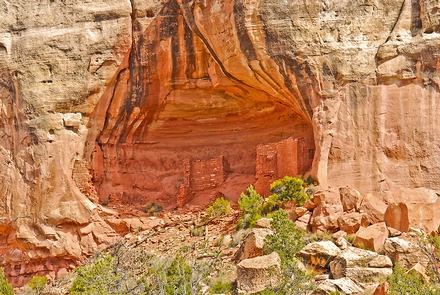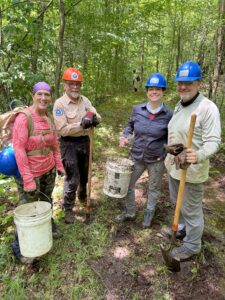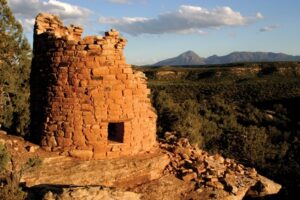 We got the chance to chat with Jeffrey Morris, the Outdoor Recreation Planner at Canyon of the Ancients National Monument to learn more about our planned project and this area. This Colorado National Monument is 260 miles northwest of Albuquerque, NM, 110 miles southeast of Moab, UT, and is less than 50 miles from the Four Corners Monument. Depending on your route, you can easily visit/view Mesa Verde National Park, Hovenweep National Monument, Shiprock, and more.
We got the chance to chat with Jeffrey Morris, the Outdoor Recreation Planner at Canyon of the Ancients National Monument to learn more about our planned project and this area. This Colorado National Monument is 260 miles northwest of Albuquerque, NM, 110 miles southeast of Moab, UT, and is less than 50 miles from the Four Corners Monument. Depending on your route, you can easily visit/view Mesa Verde National Park, Hovenweep National Monument, Shiprock, and more.
Learn more about this project or snag one of the few remaining spots here!
How long have you been working at Canyon of the Ancients National Monument (CANM) and what is your position?
I have been the Outdoor Recreation Planner at CANM since June of 2022. Prior to that, I was the Supervisory Park Ranger out of the Monticello Field office for Kane Gulch Ranger Station and the San Juan River Program. I also put in a number of years with the NPS, with the bulk of that time served at Rocky Mountain National Park.
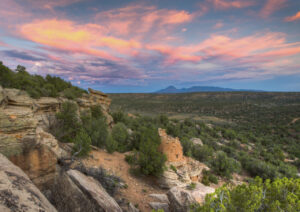 Can you tell us some fun facts about Canyon of the Ancients National Monument (CANM)?
Can you tell us some fun facts about Canyon of the Ancients National Monument (CANM)?
CANM has an estimated 37,000 cultural sites within the monument boundary and contains the highest density of cultural sites of anywhere in the continental USA. The Sand Canyon Trail system that we will be working on is unique in that it is one of the few trail complexes I know of that allow for multi-use travel, so visitors can hike, bike, or ride a horse to several of our backcountry, public cultural sites with a dog! The Monument also contains 4 Wilderness Study Areas, 1 of which is currently being proposed through federal legislation to receive the wilderness stamp by Congress (this is through the DeGette Bill).
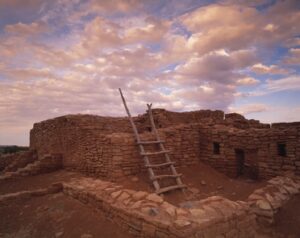 In your opinion, what makes the Canyon of the Ancients National Monument a unique or special place to visit and learn more about?
In your opinion, what makes the Canyon of the Ancients National Monument a unique or special place to visit and learn more about?
CANM was created to preserve the cultural sites and cultural landscape of the Ancestral Puebloan people. 26 tribes cite a direct ancestral connection to this location. Humans have been doing human things here for a long time. AT CANM we are on the cutting edge of educating the public on how those who claim an ancestral connection to a landscape want us to visit in a way that is respectful and honors the previous inhabitants as well as the current descendants.
Our planned project is to close social trails and brush within the Sand Canyon Trails System. Work may also involve replacing signage, cairn rebuilding, and rehabilitating trail corridors, Can you tell us more about this project? How was this need identified? How long has it been on the proverbial “to-do list”?
Due to the cultural sensitivity to Sand Canyon, trail projects can be challenging to get approved. And yet, we are contending with increased visitation and resource impacts. We came up with a project that could provide the best solution to our impacts while having the lightest impact on archeology. A project that volunteers could enjoy doing and provide the opportunity to learn about our monument.
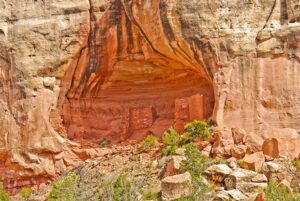 We ask visitors to stay on the trails in Sand Canyon. Off trail travel is not encouraged, however, we see a lot of activity in the form of social trails. We like to keep pace with closing those trails once they are reported. Some of these trails veer off to sensitive cultural sites that we do not advertise to the public, nor are permitted to. This project also serves to preserve the erosion of biological soils that are commonly found on the Colorado Plateau as well as archeological sites.
We ask visitors to stay on the trails in Sand Canyon. Off trail travel is not encouraged, however, we see a lot of activity in the form of social trails. We like to keep pace with closing those trails once they are reported. Some of these trails veer off to sensitive cultural sites that we do not advertise to the public, nor are permitted to. This project also serves to preserve the erosion of biological soils that are commonly found on the Colorado Plateau as well as archeological sites.
Do you know how many visitors the Canyon of the Ancients National Monument sees per year?
Canyons of the Ancients National Monument sees roughly 167,296 visitors per year. The Canyons of the Ancients Visitor Center and Museum sees about 26,447 visitors per year.
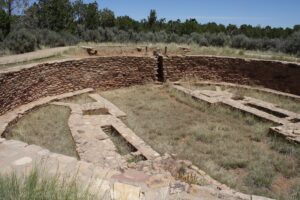 We’ve worked with you for several years now, originally with the Monticello BLM. Please share anything about your experience working with our volunteers or organization (or volunteer groups in general). Alternative question: What is the value of volunteer groups to Canyon of the Ancients National Monument?
We’ve worked with you for several years now, originally with the Monticello BLM. Please share anything about your experience working with our volunteers or organization (or volunteer groups in general). Alternative question: What is the value of volunteer groups to Canyon of the Ancients National Monument?
The work itself that volunteers complete is wonderful. We could not complete our long list of tasks without assistance from people who want to spend their free time doing manual labor, in harsh environments. BUT my hope is the biggest value we get is we recruit new advocates to the visit with respect to messaging in regards to public etiquette at cultural sites.
It is my hope that our volunteers will have an opportunity to learn about our resource impact issues at these sites and be able to share that information with friends, family, or whoever wants to visit. I encourage everyone to visit and to get an opportunity to engage their curiosity. I hope these cultural sites conjure up introspective moments of wonder and awe in an individual, but at the forefront, I want to respect the people who are ancestrally connected to this space and I want others to appreciate that connection as well. Sand Canyon will be a fun location to work because we will be encountering a multitude of beautiful sites that will spark excellent conversation and further questions.
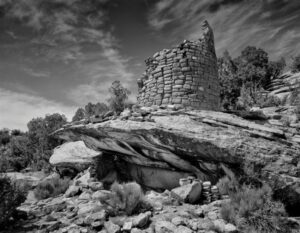 What would you say to someone who’s considering but is on the fence about joining this project?
What would you say to someone who’s considering but is on the fence about joining this project?
What’s stopping you? LOL. Seriously, you will get to work in a spectacular canyon with an intense and beautiful human history at a perfect time of year when the temps are hospitable.
What are some challenges your unit faces in managing the Canyon of the Ancients National Monument?
We are a national monument that houses the largest federal curation facilities in the BLM, a museum, and almost 200,000 acres of land to manage. And when fully staffed, which we currently are not, we have 12 people tasked to take that responsibility on. So we have to be realistic about what we intend to accomplish and what we actually can accomplish!
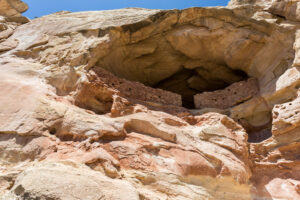 In your opinion when recreating in Canyon of the Ancients National Monument, what’s your favorite thing to do and place to do it? Alternative questions: any off-the-beaten-path recommendations?
In your opinion when recreating in Canyon of the Ancients National Monument, what’s your favorite thing to do and place to do it? Alternative questions: any off-the-beaten-path recommendations?
I love to run and hike and so where we will be working in Sand Canyon is my favorite place to go. The monument itself is off the beaten path. Our museum located outside of Dolores is a must stop when in SW Colorado and provides an excellent background on the ancestral Puebloan history and landscape
I love to run and hike and so where we will be working in Sand Canyon is my favorite place to go. The monument itself is off the beaten path. Our museum located outside of Dolores is a must-stop when in SW Colorado and provides an excellent background on the ancestral Puebloan history and landscape.
What’s your favorite piece of outdoor recreation gear and why?
My sunglasses (they’re prescription, so that helps!). We get well over 300 days of sunshine and the sun can be menacing out here! But I also get grumpy after two consecutive days of consistent cloud cover.

